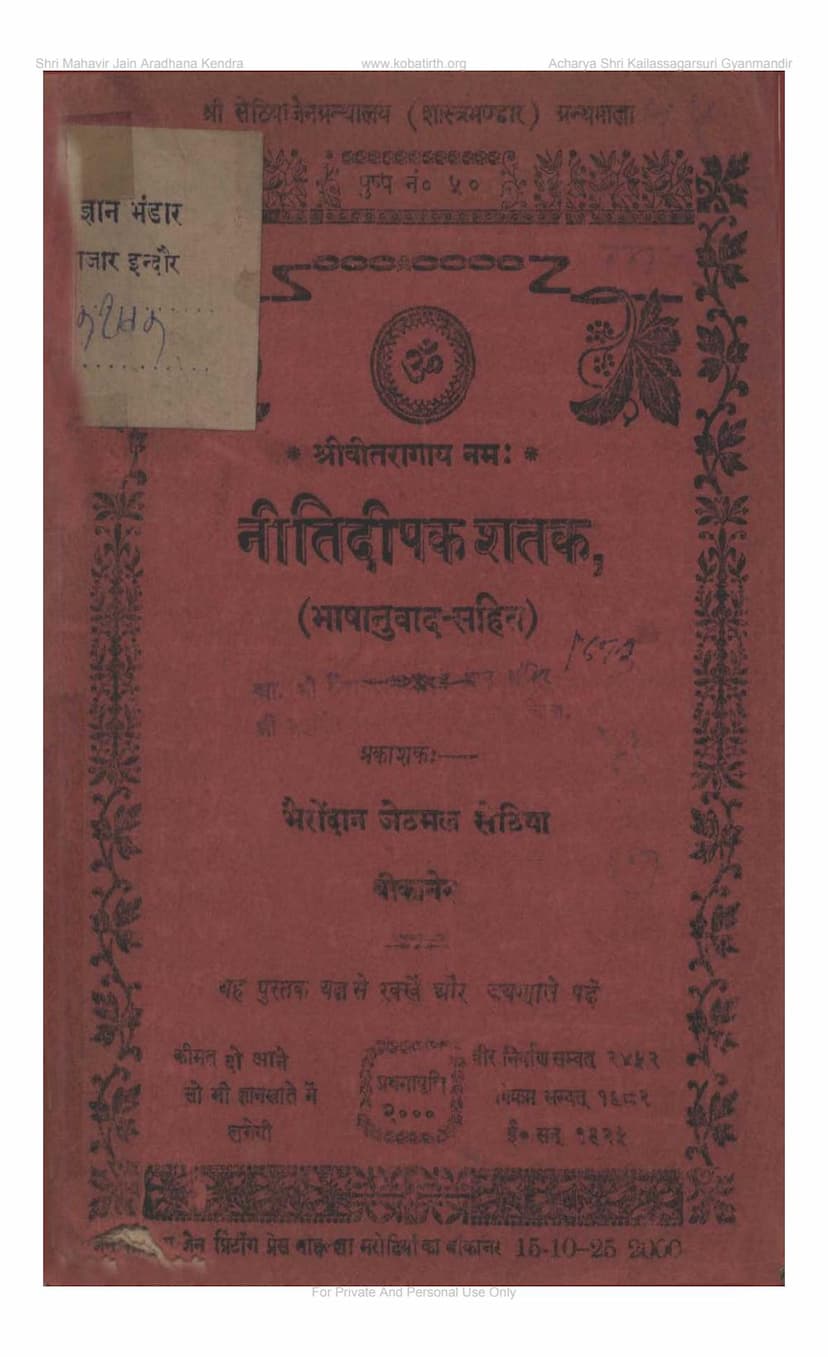Niti Dipak Shatak
Added to library: September 2, 2025

Summary
Here's a comprehensive summary of the Jain text "Niti Dipak Shatak" by Bhairodan Jethmal Sethiya, based on the provided pages:
Niti Dipak Shatak: A Beacon of Jain Wisdom and Morality
"Niti Dipak Shatak" (meaning "One Hundred Verses of the Lamp of Morality") is a Jain text authored by Bhairodan Jethmal Sethiya, published by the Sethiya Jain Granthmala. The book, translated into Hindi with explanations, serves as a guide to righteous living and spiritual progress according to Jain principles. It is a collection of verses (shlokas) offering moral guidance and wisdom for the upliftment of the soul.
Core Themes and Content:
The text systematically covers a wide range of ethical and spiritual concepts crucial to Jainism, emphasizing the practical application of these principles in daily life. Key themes include:
- Invocation and Humility (Mangalacharan): The work begins with an invocation to the first Tirthankar, Lord Adinath, acknowledging his divine qualities and seeking his protection. The author also expresses humility regarding his own spiritual attainment.
- The Value of Human Birth: The text repeatedly highlights the extreme rarity and preciousness of human birth, emphasizing that it should not be wasted on trivial pursuits but utilized for spiritual endeavors like practicing Dharma (righteousness).
- The Importance of Dharma: Dharma is presented as the sole means to salvation (Moksha) and the provider of prosperity and happiness in both worldly and spiritual life. It is the ultimate goal that should be pursued above all else.
- Renunciation of Worldly Desires: The verses strongly advocate for renouncing attachment to worldly pleasures, wealth, and sensual desires, which are depicted as fleeting and ultimately leading to suffering.
- The Dangers of Vice: The text elaborates on the destructive nature of various vices, including:
- Kama (Lust/Desire): Depicted as a source of immense suffering and a hindrance to spiritual progress.
- Artha (Wealth): While necessary, its excessive pursuit and attachment are criticized.
- Krodha (Anger): Described as a root of many evils, destroying peace, intellect, and relationships.
- Lobha (Greed): Seen as a great obstacle to knowledge, contentment, and spiritual growth.
- Moha (Delusion/Attachment): A fundamental cause of suffering, leading to distorted perception.
- Maya (Deception/Illusion): Condemned as a path to ruin, leading to self-deception and ultimate loss.
- Steya (Theft): Its negative consequences on reputation and prosperity are emphasized.
- Abrahmacharya (Unchastity): The breaking of the vow of celibacy is shown to lead to loss of honor, health, and spiritual progress.
- Himsa (Violence): Universally condemned as a root sin with severe consequences.
- The Power of Virtues: Conversely, the text extols the virtues that lead to spiritual advancement:
- Satya (Truthfulness): Presented as foundational to all virtues, bringing prosperity, respect, and a clear conscience.
- Ahimsa (Non-violence) and Daya (Compassion): Highlighted as essential for spiritual liberation, the means to navigate the ocean of existence, and the path to ultimate happiness.
- Asteya (Non-stealing): Praised for bringing honor, prosperity, and freedom from distress.
- Brahmacharya (Celibacy): Its benefits include health, peace, fame, and spiritual growth.
- Santosha (Contentment): Described as a powerful antidote to vices, bringing inner peace and material well-being.
- Sheel (Conduct/Virtue): The practice of virtuous conduct is essential for spiritual well-being.
- The Role of the Guru and Sangha: The text emphasizes the crucial role of a spiritual guide (Guru) in navigating the complexities of life and the spiritual path. It also highlights the importance of the Jain Sangha (community of monks, nuns, and lay followers) as a source of support and spiritual guidance.
- The Significance of Jain Scriptures: The divine words of the Tirthankaras (Vitraag Vachana) are presented as the ultimate source of truth and guidance, capable of discerning right from wrong and leading to liberation.
- The Practice of Devotion and Worship: The text advocates for devotion to the Arhats (Tirthankaras) and the proper worship of Jinas (idols of Tirthankaras) as means to purify the mind and attain spiritual merit.
- The Importance of Right Conduct: Throughout the verses, there is a consistent emphasis on right conduct, ethical behavior, and the cultivation of positive qualities.
Structure and Style:
The "Niti Dipak Shatak" is structured as a series of verses, each offering a moral lesson or a point of spiritual advice. The language used is accessible, with a Hindi translation and explanation provided for each verse, making it understandable to a wider audience. The verses often use metaphors and analogies from nature and daily life to illustrate their teachings effectively.
Overall Message:
The overarching message of "Niti Dipak Shatak" is to guide individuals towards a life of virtue, righteousness, and spiritual discipline. It encourages detachment from worldly possessions and desires, the practice of compassion and non-violence, and unwavering faith in the teachings of the Tirthankaras and the guidance of a Guru. By adhering to these principles, individuals can overcome the cycles of suffering, achieve inner peace, and ultimately attain liberation (Moksha).
In essence, the book acts as a spiritual lamp, illuminating the path to moral and spiritual excellence for all who seek it.